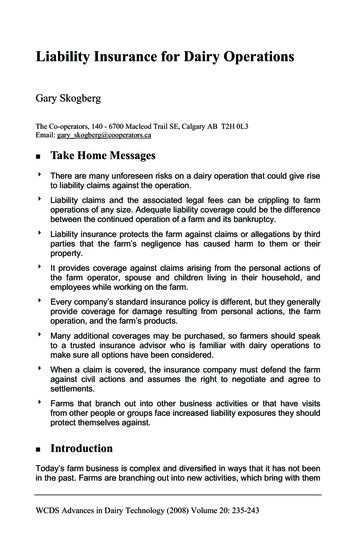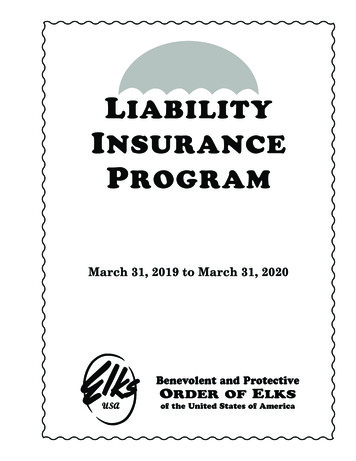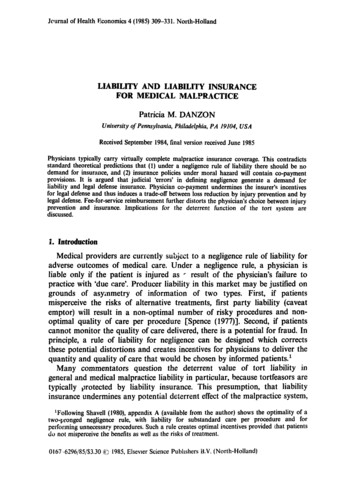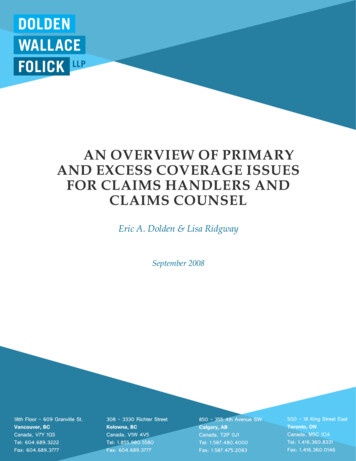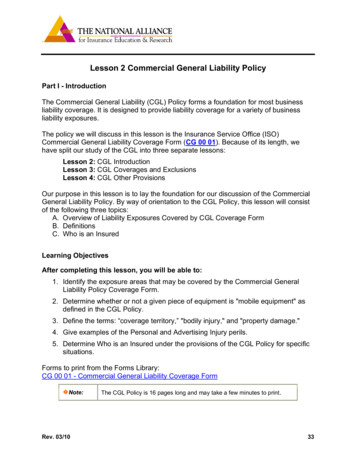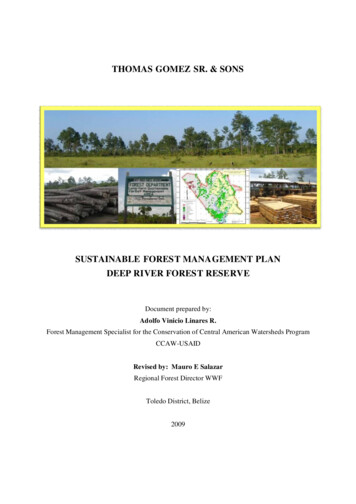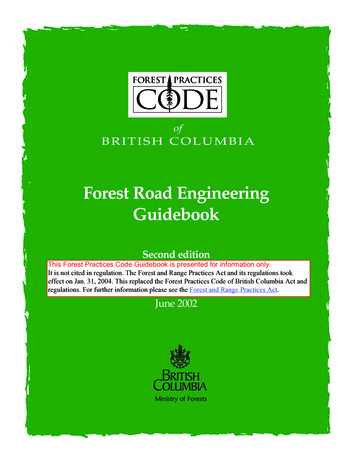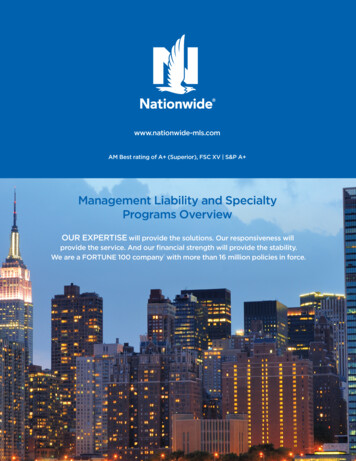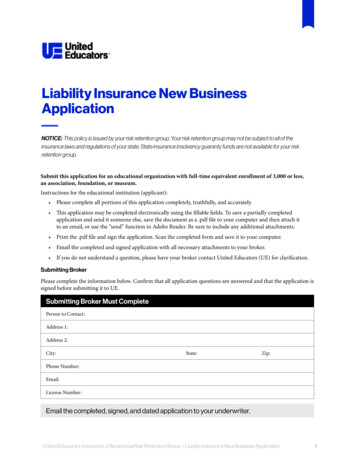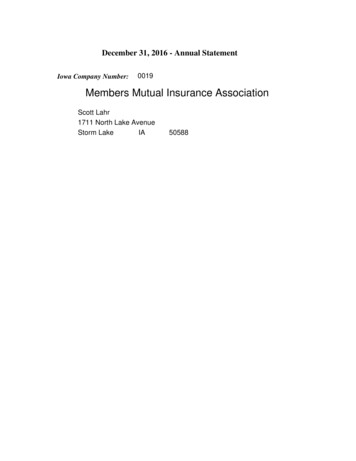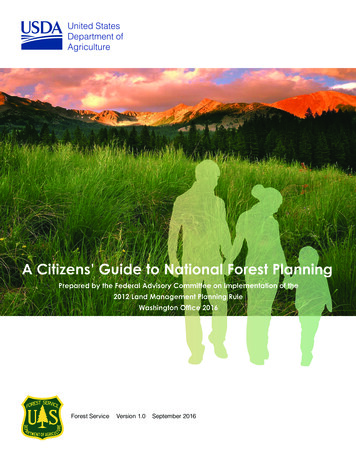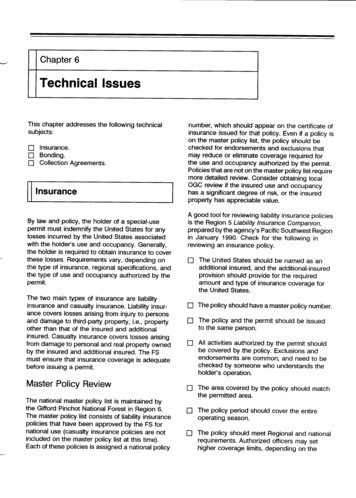
Transcription
Chapter 6: Technical Issuesnature of the authorized activity and the degree ofattendant risk.****The policy should require 30 days' prior writtennotice of cancellation (other than for nonpayment of premiums, which should require 10days' prior written notice).The policy should be an occurrence policy,rather than a claims-made one. Under anoccurrence policy, a claim can be made afterthe policy period has expired, as long as theloss occurred while the policy was in effect.Under a claims-made policy, a claim must bemade while the policy is in effect. Claims-madepolicies are unacceptable unless they have anextended reporting period. Check Section V ofthe policy to see if the insured has at least 60days to report claims after the policy hasexpired.A violation of a warranty in the policy should notvoid coverage.If claims are reduced by the cost of defendingthem, coverage should be increased commensurately.Liability InsurancePermit Clause 111.1.1 of FS-2700-4hrequires the holder to obtain liability insurance forany losses arising out of the holder's use andoccupancy of National Forest System lands. Seealso FSM 2713.32 and 2721.41.Under FSM 2713.32, the minimum amount ofliability insurance coverage is 100,000 for injury ordeath to one person, and 200,000 for injury ordeath to two or more people. Check for anyRegional supplements that may have increasedthese amounts. If there is a need, higher limits maybe required. The actual amount of liability coverageshould be determined by the authorized officer, andin many cases may be significantly higher than theminimum requirements in national policy. Inexercising that discretion, the authorized officershould consider:***The level of inherent risk associated with theuse and occupancy.The potential for an incident that may cause injury ordeath arising out of the use and occupancy.If such an incident were to occur, the potential forinjury or death to only one person, versus the potentialfor injury or death to more than one person.Examples of accidents at concession campgrounds couldinclude trees felled by wind damaging automobiles orkilling people; a swimmer attacked by an alligator at adeveloped swim area; and a bear attack at a concessionsite. In cases involving death, multimillion-dollar claimsare not uncommon.Casualty InsurancePermit Clause 111.1.2 of FS-2700-4h requires casualtyinsurance for Government property covered by the permit,including the land and Government-owned improvements.The types of loss to be covered include but are not limitedto fire suppression costs, damage (including vandalism)to Government-owned improvements covered by thepermit, and to the extent provided in clause III.I.2, costsassociated with the release or threatened release ofhazardous material.To ensure the rapid repair or replacement of essentialvisitor facilities, the holder will normally need to purchaseeither full-replacement or current-value coverage. Fullreplacement coverage pays up to the dollar limit in thepolicy for the cost to restore or replace the damaged ordestroyed property, without deduction for physicaldepreciation. Current-value coverage pays up to the dollarlimit in the policy for the current value of the damaged ordestroyed property, taking into account physicaldepreciation.Full-replacement coverage provides the greatestprotection to the Government and the public for repair orreplacement of needed facilities. However, fullreplacement coverage may be expensive. Review theconcession feasibility analysis (or concession revenue, forexisting concessions) to determine whether theconcession income can support full-replacementcoverage. Current-value coverage may be an acceptablealternative, depending on the circumstances. In the eventof6-2
Chapter 6: Technical Issuescatastrophic loss, the site will be evaluated forrebuilding. (See FS-2700-4h, Clause III.E.)Insurance for Multiple PermitsTo determine an appropriate amount of coverage,evaluate which facilities are essential to theconcession, and the risk of damage to multipleimprovements, such as toilet and shower buildings.Determine replacement values for essential improvements. Document the basis of propertydamage insurance, and attach a list of facilities andtheir replacement values to the permit.Historic structures may be prohibitive in cost toreconstruct in kind. Insurance premiums mayexceed what could reasonably be expected to bepaid by the holder. In some cases, it may be best toreplace an historic structure with a modern building,which can accommodate the functions and capacityof the original structure.The minimum amount of casualty insurancecoverage should be the value of the most expensivebuilding at the site. The authorized officer shouldrequire a higher amount where there is a high risk ofloss associated with the use and occupancy thatcould exceed the minimum.Combined-Single-Limit PoliciesMany liability insurance policies offer coverage thatdoes not have separate limits for personal injury ordeath to one person, personal injury or death tomore than one person, and third-party propertydamage. Rather, all three types of loss in theaggregate are subject to a single limit. A claim of upto that limit can be made for either type of loss, orboth types of loss combined. The insuranceprovided by such policies is known as combinedsingle-limit (CSL) coverage.For CSL policies, the minimum amount of coverageshould equal the amount of coverage desired forpersonal injury or death to more than one personplus the amount desired for third-party propertydamage. Evaluate the risk associated with bothtypes of loss, and establish an amount of coveragethat is adequate for both. Thus if 200,000 isdesired for personal injury or death to more thanone person and 100,000 is desired for third-partyproperty damage, the CSL minimum should be 300,000.6-3If the holder is using one policy to insure more thanone permit, add a rider that lists each site and thatstates that each site is covered up to the dollar limitsin the policy.Insurance for Permits Issued toStatesIf the prospective holder is a state or one of itspolitical subdivisions, a risk assessment andinsurance policy may be required if the state or itspolitical subdivision has statutory or constitutionalauthorities limiting its liability or obligation toindemnify. See the user notes for Clause lil.l in FS2700-4h.Insurance for Permits Issued toFederal AgenciesIf the prospective holder is a Federal agency,insurance is not required. Substitute languageshould be used that addresses limitations imposedby Federal law on assumption of liability by aFederal agency under the permit. See the usernotes for Clause lll.l in FS-2700-4h.Administering Insurance CoverageAdequate insurance coverage is a prerequisite topermit issuance; Within 30 days of the selectiondecision, the selected applicant must provide a copyof the insurance policy for the use and occupancy tobe authorized under the permit to the FS for review.If the policy is included in the master policy list, ithas been reviewed by the FS, and a quickcomparison can be made with the master policy tocheck for any exclusions or endorsements thatmight affect required coverage. If the policy is notincluded in the master policy list, review the policy indetail, to ensure that it affords the requiredcoverage.Proceeds recovered by the United States underliability insurance policies must be deposited into theTreasury as miscellaneous receipts. For casualtyinsurance policies, the FS has the discretion eitherto require the concessionaire to use all proceedsrecovered to repair, rebuild,
Chapter 6: Technical issuesrestore, or replace damaged Government propertycovered by the policy, or to obtain payment of theproceeds from the concessionaire or the insurancecompany. (See FS-2700-4h, Clause 111.1.2.)Casualty insurance proceeds paid to the FS mustbe deposited into the Treasury as miscellaneousreceipts, rather than spent at the site to rectify thedamage.mine whether bonding should be required, and, ifso, an appropriate amount. It is the agency's optionto require bonding; however, it should be addressedin the prospectus. After a satisfactory operatingseason, the authorized officer may reevaluate theneed for, or reduce the amount of, the bond.The bond should provide that at the agency’soption, the surety must pay the United States forany loss covered by the bond, or, in the event ofrevocation or suspension of the permit or completedefault under the permit, must pay a thrid party(NOT THE FS) to operate the concession. ANYBOND PROCEEDS RECOVERED BY THE FSMUST BE DEPOSITED INTO THE TREASURY ASMISCELLANEOUS RECEIPTS. THE FS MAY NOTUSE BOND PROCEEDS TO OPERATE THE SITE.BondingIn the context of the agency's concession program,bonding is a type of guarantee that protects theUnited States against financial loss resulting fromdefaulted obligations associated with special-usepermits. A bond ensures obligations or paymentsassociated with these permits.The bond should also provide that selection of athird party to operate the site is subject to FSapproval. Upon approval, the FS would issue atemporary permit to the third party to operate theconcession for a period up to the balance of thepermit term. After a new holder is in place, theoperational costs of the concession will be coveredby concession revenues. In addition, the new holderwill be responsible for all obligations under thepermit. Once the permit term expires, a newprospectus must be issued for the concession (seeFS-2700-4h, Clause J).Do not use bonds to enforce general terms of thepermit. Rather, use bonds to enforce readilyidentifiable requirements that are specified in FS2700-4h, Clause J. Also, do not use bonds as asubstitute for enforcement action under the permit,such as suspension or revocation. Bonding shouldnot be necessary for permit fee requirements, aspermit fees should be paid in advance of theauthorized use and occupancy. Bonding isparticularly appropriate to protect the United Statesfrom a complete default under the permit. (See FSM2344.2, item 4; FSM 2713.34; and FSH 6509.11k,Chapter 80, for direction on the use of bonding.)Type of BondThe agency has the discretion to require bonding. Ifit is required, it should be addressed in theprospectus. The amount of the bond should besufficient to coyer the anticipated loss. For example,the bond may be based on the cost of operating thesites for the remainder of a season, the cost for anew holder to start operating, the amount of cash onhand required by the FAD, or the amount ofservices that the holder is committed to provide,based on reservations. If multiple permits arecovered by a blanket bond (see FSH 6509.11 k,sec. 81.2), the amount of the bond should besufficient to cover the anticipated loss under allpermits covered by the bond.A performance bond may be required to secureobligations imposed under the permit, in accordance with FS-27004h, Clause J. Either the FS willdevelop a performance bond form for special usesor adapt General Services Administration (GSA)Form SF-25, Performance Bond (see Appendix 6A,page 6-7). (Although GSA Form SF-25 is approvedfor use for special-use permits, before it can beused in conjunction with this desk guide, the FSmust obtain approval from GSA to modify the formto make it consistent with that use, and to allow theFS to require the surety to pay a third party tooperate the concession in the event of a completedefault.) The term of the bond should cover theperiod needed to secure obligations under thepermit, which typically would be the length of thepermit term.Review the economic-feasibility analysis to deter-6-4
Liability Insurance Permit Clause 111.1.1 of FS-2700-4h requires the holder to obtain liability insurance for any losses arising out of the holder's use and occupancy of National Forest System lands. See also FSM 2713.32 and 2721.41. Under FSM 2713.32, the minimum amount of liability insurance coverage is 100,000 for injury or
